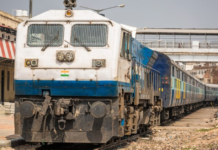
Jammu & Kashmir (Metro Rail News): Northern Railways announced the completion of India’s longest tunnel between Sumber and Arpinchala stations in the Katra-Banihal section of the Udhampur-Srinagar-Baramulla Rail Link (USBRL) project on February 15. “The main tunnel of T-49 has now been connected,” officials stated.
According to Northern Railways statement, “A major milestone has been achieved by executing the break-through of tunnel T49 between Sumber and Arpinchala Station on the ongoing Katra-Banihal Section. It is worthwhile to mention that the line and level of the tunnel are precisely achieved in break-through.”
Of the 272 km length of the Udhampur Srinagar Baramulla Rail Link Project (USBRL) project, 161 km has already been commissioned and operationalized. According to the railways, the 111 KM route between Katra and Banihal is being built rapidly.
It Stated that the Katra-Banihal Section passes through the steep terrain of the lower Himalayas, where geology poses a significant difficulty. It has several essential bridges and long tunnels that are in various phases of construction.
T49 is a 12.758 KM long tunnel that will be the longest in Indian Railway history, surpassing the Peer Panjal Tunnel, built by USBRL on the Banihal-Qazigund segment and is 11.2 km long. The south portal (S.P.) of Tunnel T-49 is located in picturesque Sumber Village at a distance of 45 km from District H.Q. Ramban of Jammu and Kashmir at an altitude of 1400 meters, while the North Portal (N.P.) of the tunnel is located near Arpinchala village Tehsil Khari, District Ramban, in Mahu-Mangat Valley at an altitude of 1600 meters approximately.
The T-49 tunnel is divided into two sections: the main tunnel and the escape tunnel. The tunnel was built using the NATM (New Austrian Tunneling Method), a modern drill-and-blast technique. The tunnel’s cross-section profile is modified horseshoe-shaped.
This tunnel is extraordinarily long. Three adits, called Urnihal Adit, Hingni Adit, and Kundan Adit, have also been built to ease construction. The tunnel has a 1 in 80 ruling gradient and a designed speed of 100 kilometres per hour.
To simplify rescue and repair operations, the Escape Tunnel, which is being built parallel to the Main Tunnel, is connected by cross passages every 375 metres, as per international standards.
NR entrusted the construction work to IRCON International Ltd., which divided the work into two packages and awarded them to HCC and AFCONS. As a result, HCC is working on a 5.1 KM length from South Portal, while AFCONS is working on a 7.658 KM stretch from North Portal.
According to the railways, Several issues were encountered during construction, including a shear zone, perched aquifer, and highly jointed rock mass, rock problems of squeezing, and high ingress of water.
The team of experienced engineers of Northern Railway, IRCON, and the executing agencies HCC and AFCONS successfully negotiated all challenges and made it possible to achieve this significant achievement. Agencies employed local people for various works in the region during tunnel building, which transformed the general socio-economic environment.




